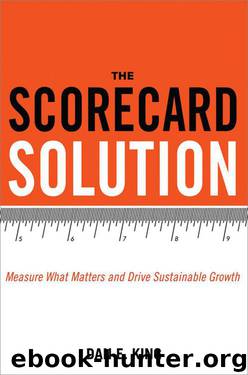The Scorecard Solution: Measure What Matters and Drive Sustainable Growth by Dan E. King

Author:Dan E. King [King, Dan E.]
Language: eng
Format: epub
ISBN: 9780814434932
Publisher: AMACOM
Published: 2015-01-14T08:00:00+00:00
STRATEGY DISSECTION
Through the new and improved strategy planning process, the Rymell Software leadership team settled on three big strategies for the coming year. Remember, these initiatives are oriented to hyper-growth and intended to push the organization beyond simple incremental growth and continuous improvement. In addition to the “big three,” the company also still has an obligation to the day job—operational improvements, technology upgrades, and so on. The existing talent is fine for the continuous improvement areas, but there is a real question whether all of the expertise needed to move out on the big three strategies is resident. Consequently, an honest examination of talent is required.
It’s October and the strategy planning for the coming year has recently been completed at Rymell Software. Strategy owners are in place and they have assembled cross-functional execution teams. Now it is time to assess talent against the tactical components of the strategy.
The broad strategy statement will not be sufficient to determine what skill sets will be needed to do the work. The strategy statement provides a reasonable description of organizational intent and is used to inform stakeholders, such as employees and the board. However, that statement is only the beginning for the team focused on turning the strategy into results. One of the first tasks of a strategy owner is to define tactical actions supporting the strategy. Only then can required skills be identified.
An effective methodology to pinpoint needed skill sets is to break down the strategy into time-boxed activity. This could be 30- or 60-day increments. The cross-functional team should be able to easily articulate the tactical actions for the first few time segments; let’s say three 30-day segments. This approach also is logical if the business has established 30-day strategy review sessions.
Once the team has the 30-day action plan documented it becomes relatively easy to align skill sets with each action. The granularity of tasks allows one to easily define the expertise needed and to determine whether the skills are available today within the organization. What is typically discovered during this exercise is that existing talent can cover a portion of the action plan, but there are talent gaps when it comes to other key deliverables. At Rymell Software, when all three strategy teams completed the talent alignment exercise, two significant realities surfaced:
1. There are bandwidth issues among current employees who are needed to play key roles in the execution of the strategies. This is not unusual. Invariably, organizations rely over and over again on the same “A” players. This is an indication of diminished talent density (see Figure 6-3).
2. A recruiting plan is needed to attract the needed skills across the three strategies.
Download
This site does not store any files on its server. We only index and link to content provided by other sites. Please contact the content providers to delete copyright contents if any and email us, we'll remove relevant links or contents immediately.
Bad Blood by John Carreyrou(6274)
Rich Dad Poor Dad by Robert T. Kiyosaki(6174)
Principles: Life and Work by Ray Dalio(5957)
Playing to Win_ How Strategy Really Works by A.G. Lafley & Roger L. Martin(5493)
Management Strategies for the Cloud Revolution: How Cloud Computing Is Transforming Business and Why You Can't Afford to Be Left Behind by Charles Babcock(4438)
The Confidence Code by Katty Kay(4035)
Thinking in Bets by Annie Duke(3995)
American Kingpin by Nick Bilton(3507)
Delivering Happiness by Tony Hsieh(3280)
Project Animal Farm: An Accidental Journey into the Secret World of Farming and the Truth About Our Food by Sonia Faruqi(3016)
The Power of Habit by Charles Duhigg(2964)
Brotopia by Emily Chang(2892)
Mastering Bitcoin: Programming the Open Blockchain by Andreas M. Antonopoulos(2891)
The Tyranny of Metrics by Jerry Z. Muller(2846)
I Live in the Future & Here's How It Works by Nick Bilton(2844)
The Marketing Plan Handbook: Develop Big-Picture Marketing Plans for Pennies on the Dollar by Robert W. Bly(2792)
The Content Trap by Bharat Anand(2778)
Building a StoryBrand by Donald Miller(2754)
Applied Empathy by Michael Ventura(2749)
